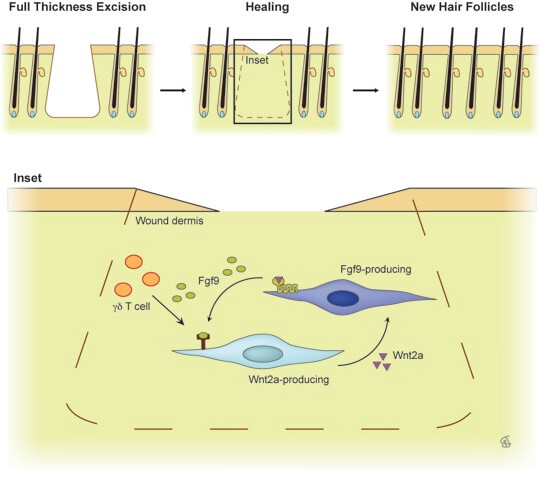Penn Medicine Study Highlights Interplay Between Immune System and Tissue Regeneration
Researchers in the Perelman School of Medicine at the University of Pennsylvania have determined the role of a key growth factor, found in skin cells of limited quantities in humans, which helps hair follicles form and regenerate during the wound healing process. When this growth factor, called Fgf9, was overexpressed in a mouse model, there was a two- to three-fold increase in the number of new hair follicles produced. Researchers believe that this growth factor could be used therapeutically for people with various hair and scalp disorders. The study appears in an advance online publication of Nature Medicine.
"The findings help explain why humans don't regenerate their hair after wounding," said senior author George Cotsarelis, MD, professor and chair of Dermatology. "The study also points us to a way to treat wounds and grow hair."
Following up on earlier work, which showed that increased signaling from the Wnt pathway doubled the number of new hair follicles, the Penn team looked further upstream in the pathway and identified an important cascade of signals that prompt further expression, as well as perpetuate and amplify signals sent during a crucial phase of hair-follicle regeneration.
Fgf9 is initially secreted from gd T cells, an unconventional, rare subset of T cells involved in the immune response. Once released, Fgf9 serves as the catalyst for a signal sent via the dermal Wnt pathway. The signal prompts further expression of Fgf9 in structural cells called fibroblasts, and adds to the generation of new hair follicles.
When a wound occurs in an adult person, hair follicle growth is blocked and the skin heals with a scar. However, hair does regenerate to a great extent in the wound-healing process in mice. The team compared how the process works in adult mice versus humans. Humans have low numbers of gd T cells in their skin compared to mice, and this may explain why human skin scars but does not regenerate hair follicles.
In adult mice, the amount of Fgf9 secreted modulates hair-follicle regeneration after wounding. When Fgf9 was reduced, there was a decrease in wound-induced hair follicle growth. Conversely, when Fgf9 was increased, there was a two- to three-fold increase in the number of new hair follicles, equal to the amount seen in the mice expressing Wnt. Importantly, when the investigators added Fgf9 back to the wounds that do not normally regenerate, FGF9 triggered the molecular cascade of events necessary for skin and hair regeneration; thus, leaving the door open for using Fgf9 to treat wounds and hair loss in people.
Click here to view the full release.








